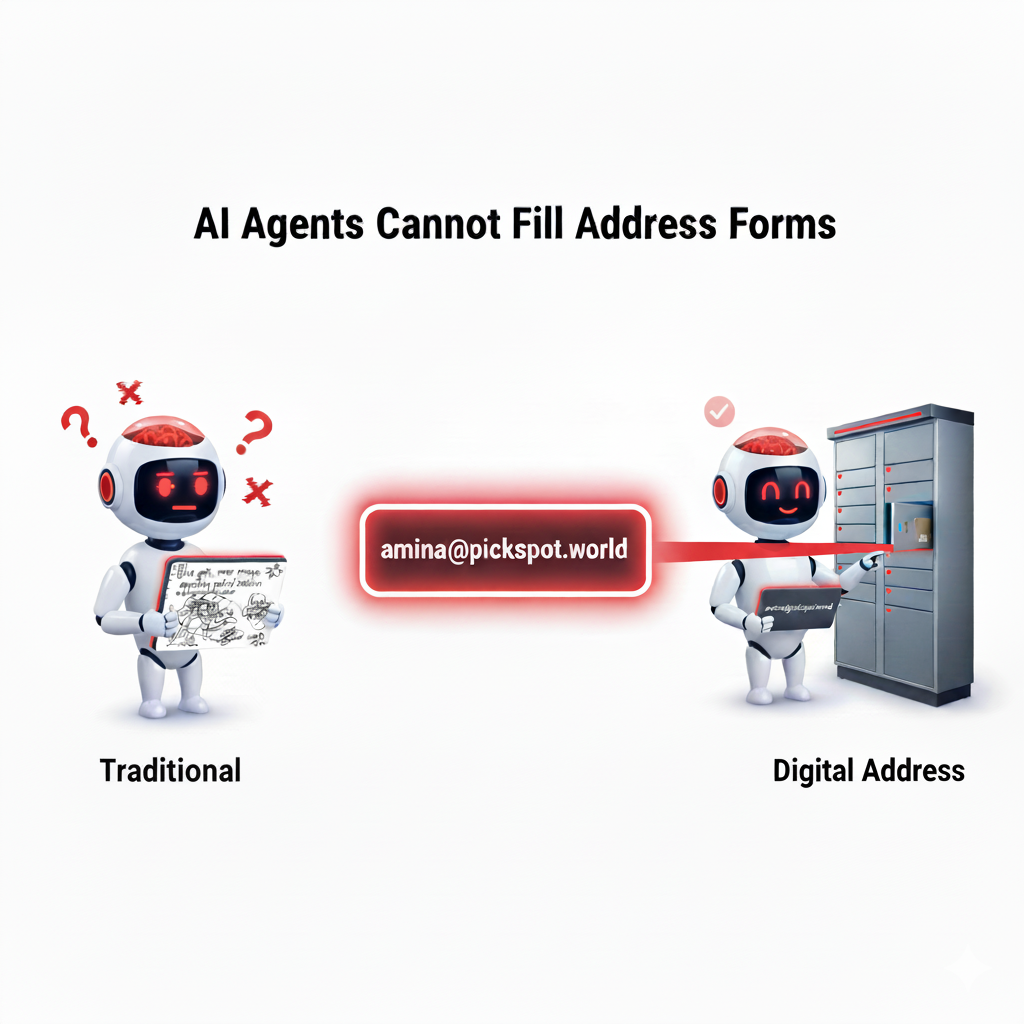
Most people see checkout forms as mildly annoying but functional. You type your address, eventually something arrives but when we started thinking about AI agents handling commerce, the fundamental...
Most people see checkout forms as mildly annoying but functional. You type your address, eventually something arrives.
But when we started thinking about AI agents handling E-commerce, the fundamental incompatibility became obvious.
A human can interpret "near the mosque, opposite the petrol station." An AI agent cannot.
AI agents need structured, machine-readable identifiers. They need deterministic endpoints, not probabilistic guesses.
The checkout form is the fax machine of e-commerce. It works until you need it to be truly digital.
Checkout forms weren't designed for the world we're entering. They were built for suburban Western households with reliable postal systems.
Billions of people don't have usable street addresses. Even in cities with addresses, couriers rely on landmarks that can't be standardized.
Every merchant, courier, and platform maintains their own patchwork fix. That's not user experience optimization. That's broken infrastructure.
The numbers prove the scale of this failure. Checkout abandonment averages nearly 70% globally.
In emerging markets, the problem compounds. Traditional forms often contain 7+ form fields when a fully optimized digital address flow needs just 1 field.
AI agents already influence 19% of purchases as of 2024, up 6% from the previous year.
But AI agents can't fill out messy address forms. They need zero-ambiguity, repeatable resolution.
Consider the requirements: Error tolerance for humans ("oh, you meant that mosque") doesn't work for AI-to-AI transactions. Scale demands millions of transactions daily and can't depend on probabilistic interpretation.
Every natural language interpretation adds compute cost and latency. A structured handle is a single lookup.
Commerce involves multiple systems. Merchant, payment processor, courier, customs, warehouse. They can't all rely on different AI interpretations of the same messy text.
Digital addresses like amina@pickspot.world aren't just cleaner checkout forms. They're portable, machine-readable identifiers.
They resolve instantly to verified lockers, buildings, or pickup points. No ambiguity. No normalization required.
For consumers, checkout shrinks from 10 fields to a single handle. For merchants, addresses resolve automatically into verified endpoints.
For couriers, routes point directly to managed delivery points instead of vague directions. For AI agents, transactions flow seamlessly, agent-to-agent.
This transforms commerce from place-first to person-first. Your digital address lives with you, not at a fixed location.
Most assume AI commerce will start in Silicon Valley and trickle down. But the pain isn't symmetrical.
In developed markets, checkout forms are clunky but functional. In Nairobi, Lagos, Dhaka, they're actively broken.
The worse the infrastructure, the stronger the incentive to leapfrog. This follows the proven pattern of mobile money adoption.
M-Pesa now serves 37 million users, with 80% of Kenyans using mobile money compared to just 20% of Americans.
Digital addresses could follow the same backwards adoption pattern. Necessity in emerging markets, convenience in developed ones.
Sharp pain creates fast adoption. Where delivery is unreliable, one-handle checkout feels like survival, not optimization.
Digital addresses represent something bigger than improved logistics. They're redefining commerce identity.
Your identity in commerce has always been tethered to where you live. Street address equals anchor point.
But it's brittle. Move houses, get a new address. Travel, have no address. Informal housing, no address at all.
Digital handles flip this dynamic. You don't live at an address. The address lives with you.
It's portable across countries and cities , updatable in real time, constant regardless of geography. Your handle follows you like your WhatsApp number does today.
Geography becomes a routing layer, not an identity layer. Infrastructure becomes plug-and-play nodes.
Infrastructure transitions are notoriously unpredictable. Digital addresses could remain niche if critical density isn't reached quickly.
The existential risk is real. Without merchant integration and consumer adoption, this becomes another identity system that never scales.
But the flip side creates inevitability. Urbanization is outpacing infrastructure in the Global South's megacities.
These cities don't have the luxury of retrofitting Western-style postal systems. Something new has to emerge.
Parcel lockers have already proven superior to legacy systems in China, Europe, and the US. The model works.
The question isn't whether digital addressing will happen. It's who builds the protocol that takes it the masses.
The leap from fax to email didn't just make communication faster. It rewired how the internet worked.
Digital addresses will do the same for commerce. They're not improving the checkout experience. They're building the protocol for AI-native commerce.
This creates a logistics system that both humans and machines can trust. One that works across borders, scales to billions, and makes delivery as seamless for AI as email made communication for the web.
We're not just fixing checkout forms. We're aligning commerce infrastructure with the reality that AI agents will soon handle most of our shopping.
The future of commerce is agent-to-agent transactions. Digital addresses make that future possible.